TOYOTA iA 2016 Owners Manual (in English)
Manufacturer: TOYOTA, Model Year: 2016, Model line: iA, Model: TOYOTA iA 2016Pages: 588, PDF Size: 5.15 MB
Page 551 of 588
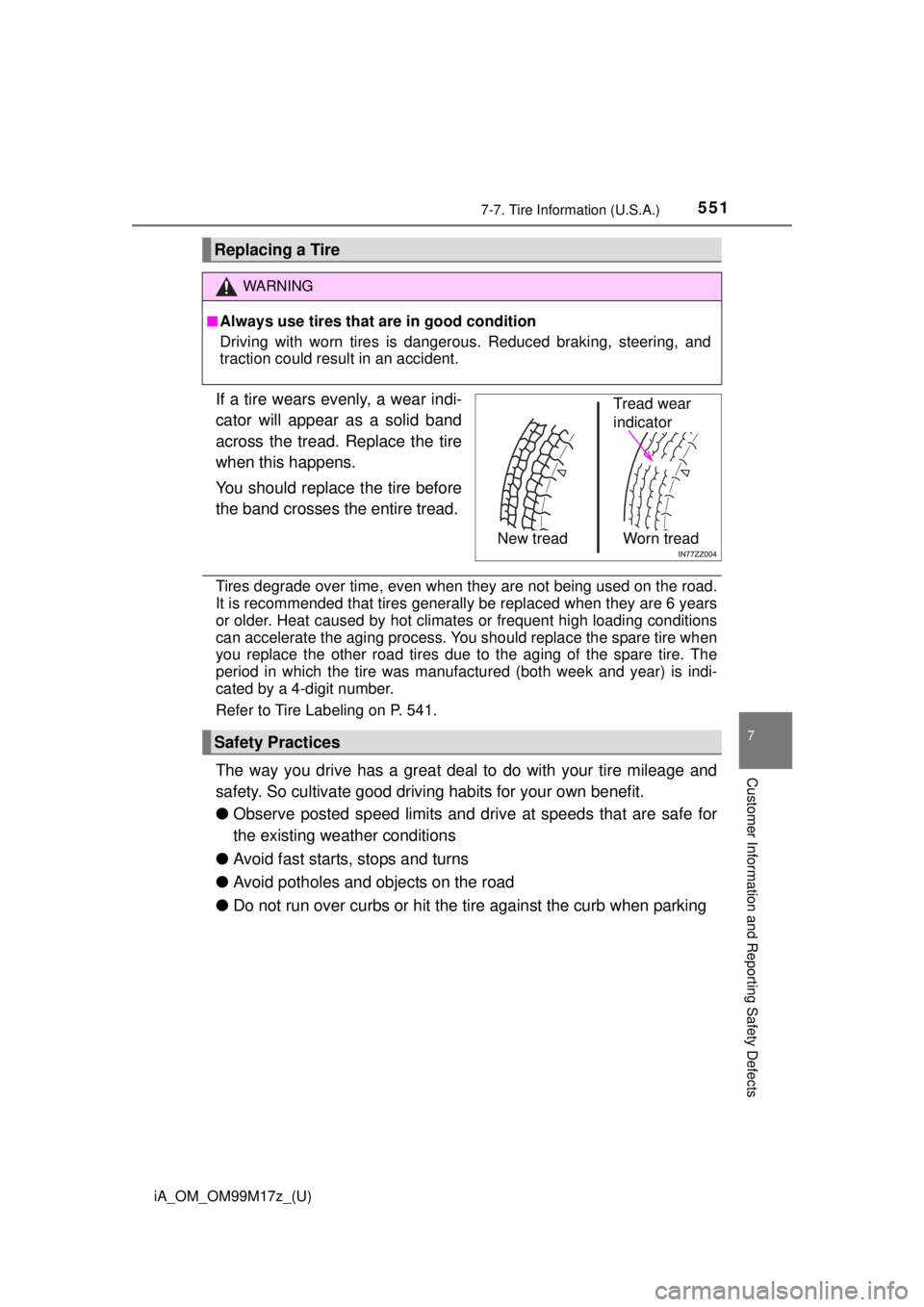
iA_OM_OM99M17z_(U)
5517-7. Tire Information (U.S.A.)
7
Customer Information and Reporting Safety Defects
If a tire wears evenly, a wear indi-
cator will appear as a solid band
across the tread. Replace the tire
when this happens.
You should replace the tire before
the band crosses the entire tread.
Tires degrade over time, even when they are not being used on the road.
It is recommended that tires generally be replaced when they are 6 years
or older. Heat caused by hot climates or frequent high loading conditions
can accelerate the aging process. Yo u should replace the spare tire when
you replace the other road tires due to the aging of the spare tire. The
period in which the tire was manufactured (both week and year) is indi-
cated by a 4-digit number.
Refer to Tire Labeling on P. 541.
The way you drive has a great deal to do with your tire mileage and
safety. So cultivate good driving habits for your own benefit.
● Observe posted speed limits and drive at speeds that are safe for
the existing weather conditions
● Avoid fast starts, stops and turns
● Avoid potholes and objects on the road
● Do not run over curbs or hit the tire against the curb when parking
Replacing a Tire
WARNING
■Always use tires that are in good condition
Driving with worn tires is dangerous. Reduced braking, steering, and
traction could result in an accident.
Tread wear
indicator
Worn treadNew tread
Safety Practices
Page 552 of 588

552
iA_OM_OM99M17z_(U)
7-7. Tire Information (U.S.A.)
NOTICE
If you feel a sudden vibration or ride disturbance while driving or you
suspect your tire or vehicle has been damaged, immediately reduce
your speed. Drive with caution until you can safely pull off the road. Stop
and inspect the tire for damage. If the tire is under-inflated or damaged,
deflate it, remove the tire and rim and replace it with your spare tire. If
you cannot detect a cause, have th e vehicle towed to the nearest vehi-
cle or tire dealer to have the vehicle inspected.
Page 553 of 588
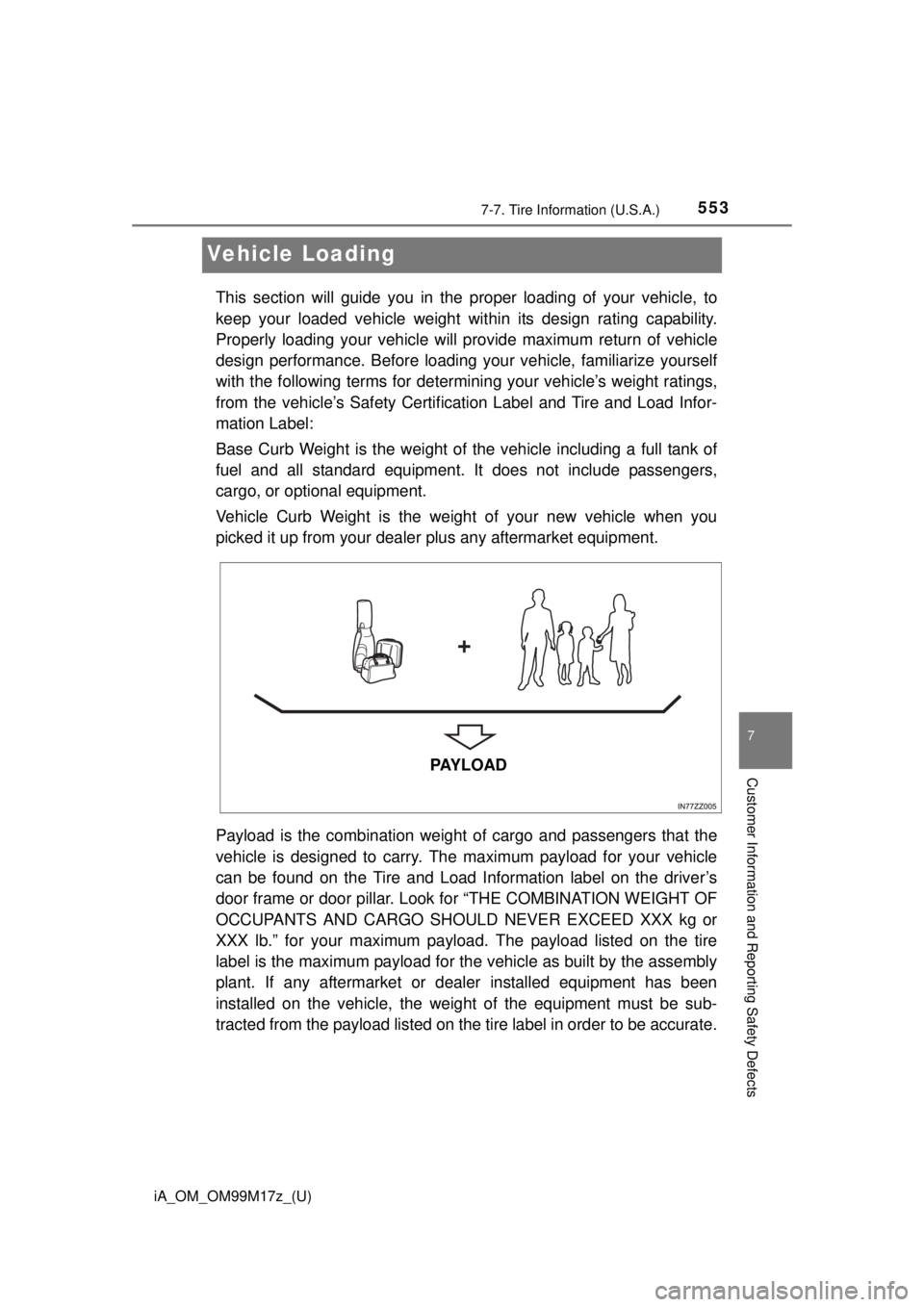
553
iA_OM_OM99M17z_(U)
7-7. Tire Information (U.S.A.)
7
Customer Information and Reporting Safety Defects
Vehicle Loading
This section will guide you in the proper loading of your vehicle, to
keep your loaded vehicle weight wi thin its design rating capability.
Properly loading your vehicle will provide maximum return of vehicle
design performance. Before loading your vehicle, familiarize yourself
with the following terms for determining your vehicle’s weight ratings,
from the vehicle’s Safety Certif ication Label and Tire and Load Infor-
mation Label:
Base Curb Weight is the weight of the vehicle including a full tank of
fuel and all standard equipment. It does not include passengers,
cargo, or optional equipment.
Vehicle Curb Weight is the weight of your new vehicle when you
picked it up from your dealer plus any aftermarket equipment.
Payload is the combination weight of cargo and passengers that the
vehicle is designed to carry. The maximum payload for your vehicle
can be found on the Tire and Load Information label on the driver’s
door frame or door pillar. Look for “THE COMBINATION WEIGHT OF
OCCUPANTS AND CARGO SHOULD NEVER EXCEED XXX kg or
XXX lb.” for your maximum payload. The payload listed on the tire
label is the maximum payload for the vehicle as built by the assembly
plant. If any aftermarket or dealer installed equipment has been
installed on the vehicle, the weight of the equipment must be sub-
tracted from the payload listed on the tire label in order to be accurate.
PAY L O A D
Page 554 of 588
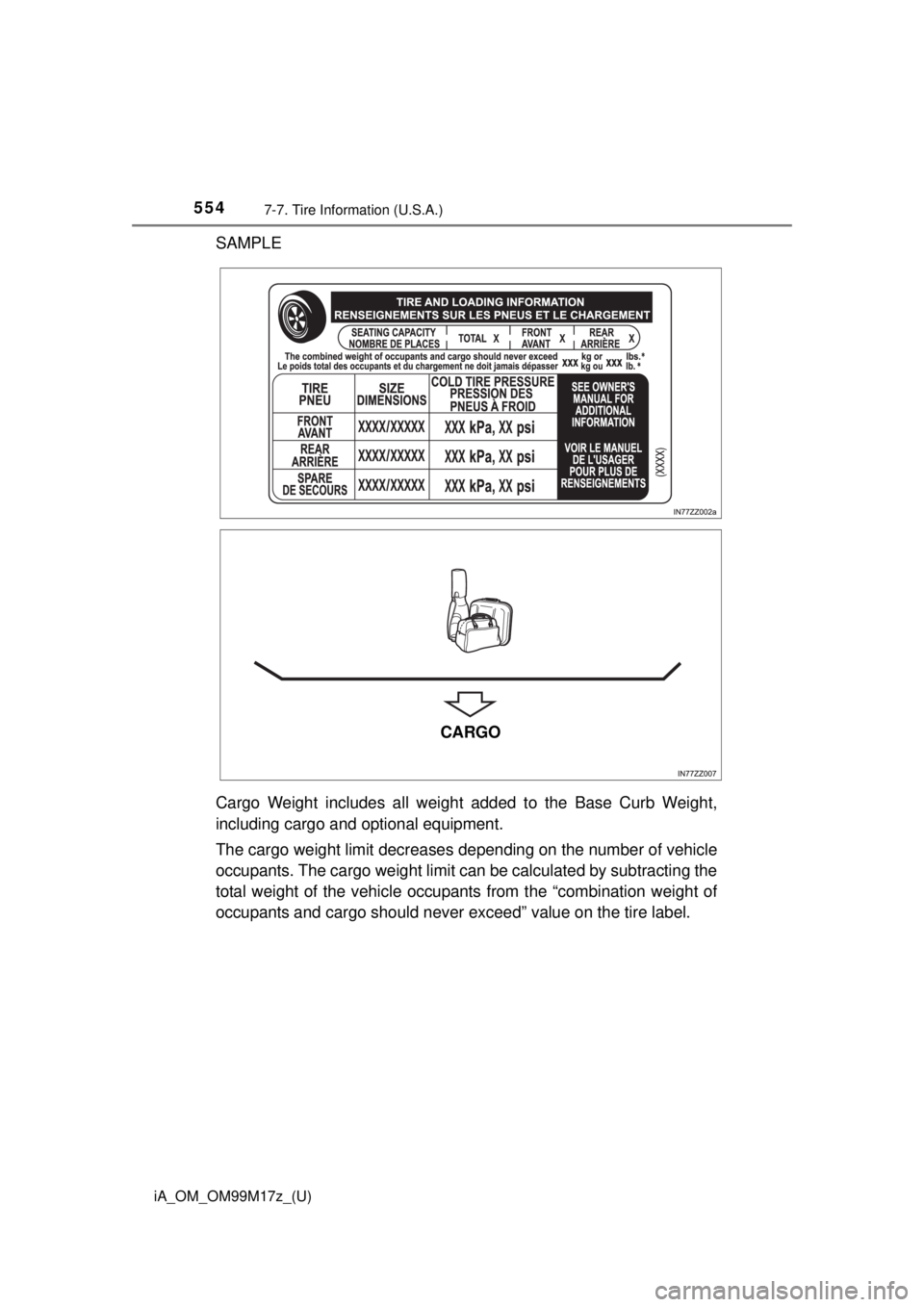
554
iA_OM_OM99M17z_(U)
7-7. Tire Information (U.S.A.)
SAMPLE
Cargo Weight includes all weight added to the Base Curb Weight,
including cargo and optional equipment.
The cargo weight limit decreases depending on the number of vehicle
occupants. The cargo weight limit can be calculated by subtracting the
total weight of the vehicle occupants from the “combination weight of
occupants and cargo should never exceed” value on the tire label.
CARGO
Page 555 of 588
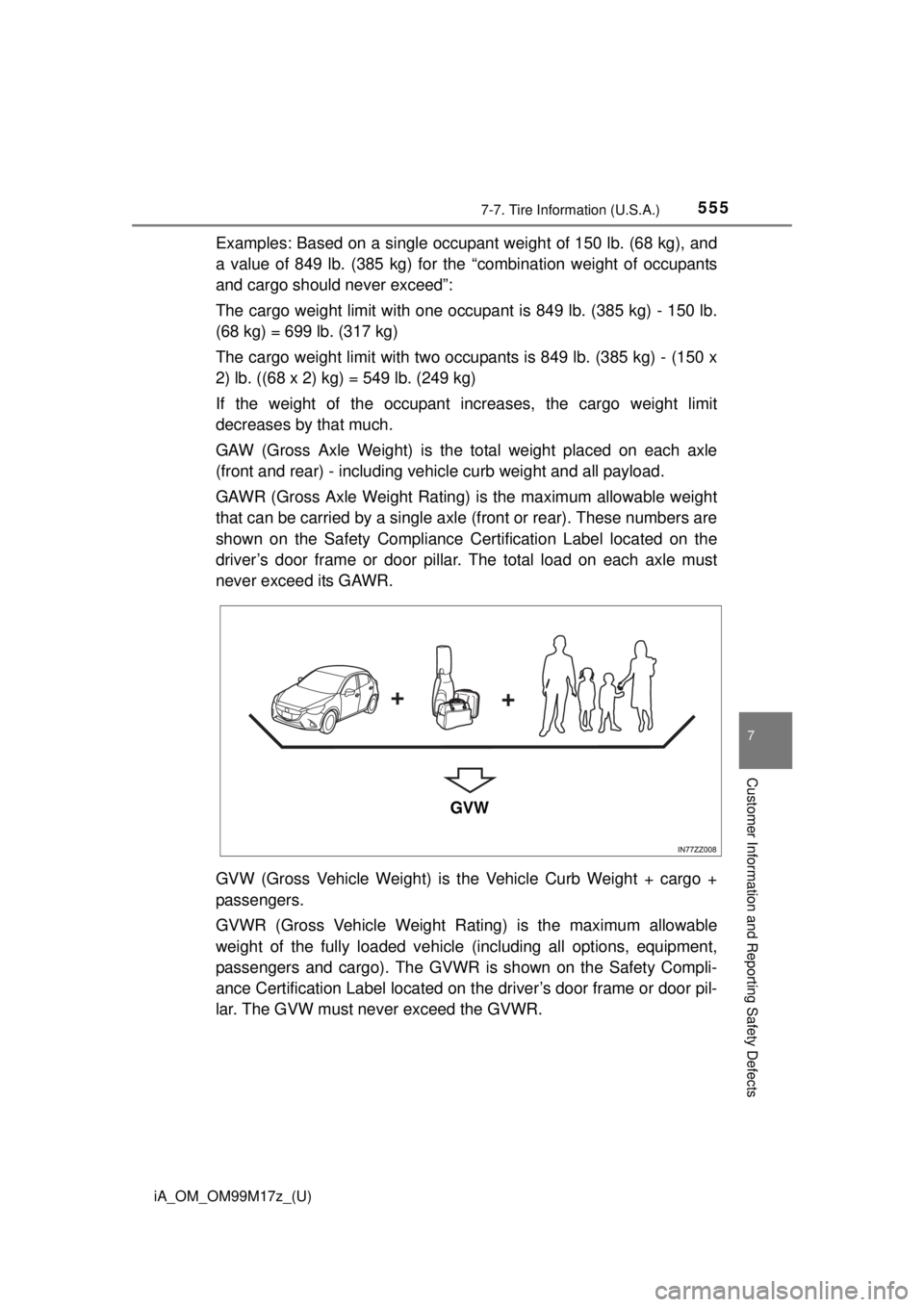
iA_OM_OM99M17z_(U)
5557-7. Tire Information (U.S.A.)
7
Customer Information and Reporting Safety Defects
Examples: Based on a single occupant weight of 150 lb. (68 kg), and
a value of 849 lb. (385 kg) for the “combination weight of occupants
and cargo should never exceed”:
The cargo weight limit with one occupant is 849 lb. (385 kg) - 150 lb.
(68 kg) = 699 lb. (317 kg)
The cargo weight limit with two occupants is 849 lb. (385 kg) - (150 x
2) lb. ((68 x 2) kg) = 549 lb. (249 kg)
If the weight of the occupant increases, the cargo weight limit
decreases by that much.
GAW (Gross Axle Weight) is t he total weight placed on each axle
(front and rear) - including vehi cle curb weight and all payload.
GAWR (Gross Axle Weight Rating) is the maximum allowable weight
that can be carried by a single axle (front or rear). These numbers are
shown on the Safety Compliance Certification Label located on the
driver’s door frame or door pillar. The total load on each axle must
never exceed its GAWR.
GVW (Gross Vehicle Weight) is the Vehicle Curb Weight + cargo +
passengers.
GVWR (Gross Vehicle Weight Rating) is the maximum allowable
weight of the fully loaded vehicle (including all options, equipment,
passengers and cargo). The GVWR is shown on the Safety Compli-
ance Certification Label located on the driver’s door frame or door pil-
lar. The GVW must never exceed the GVWR.
GVW
Page 556 of 588
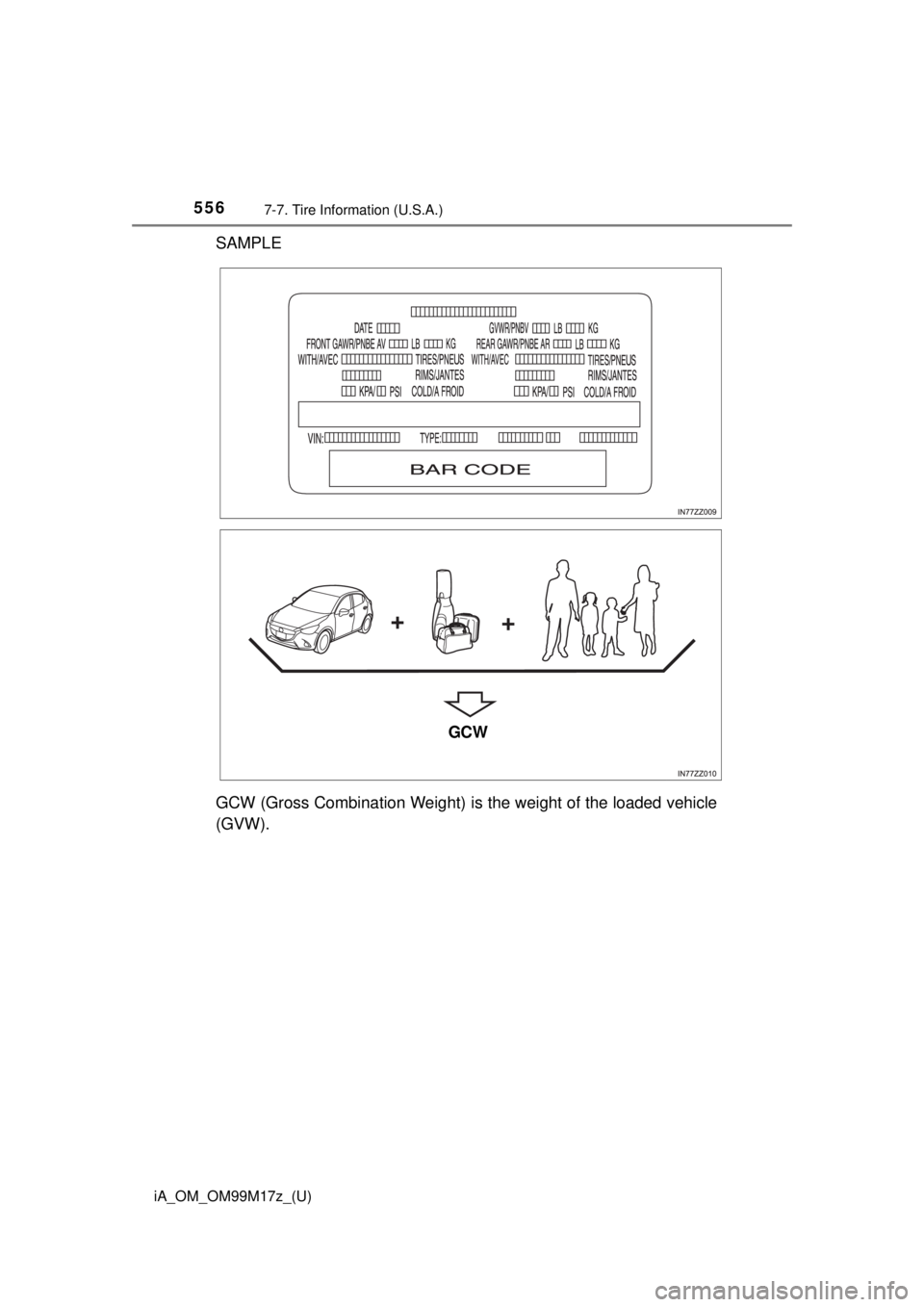
556
iA_OM_OM99M17z_(U)
7-7. Tire Information (U.S.A.)
SAMPLE
GCW (Gross Combination Weight) is the weight of the loaded vehicle
(GVW).
GCW
Page 557 of 588
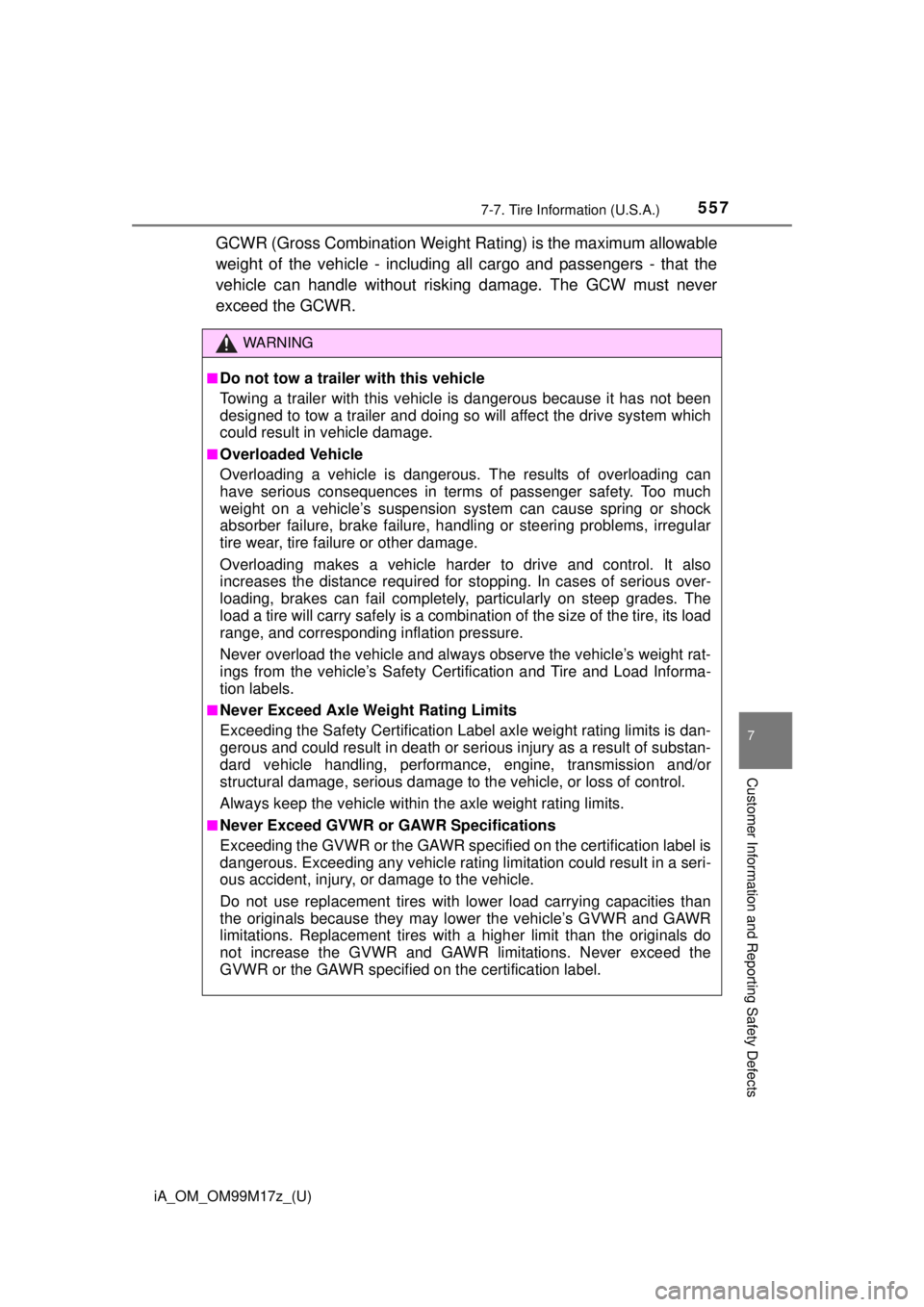
iA_OM_OM99M17z_(U)
5577-7. Tire Information (U.S.A.)
7
Customer Information and Reporting Safety Defects
GCWR (Gross Combination Weight Rating) is the maximum allowable
weight of the vehicle - including all cargo and passengers - that the
vehicle can handle without risking damage. The GCW must never
exceed the GCWR.
WARNING
■Do not tow a trailer with this vehicle
Towing a trailer with this vehicle is dangerous because it has not been
designed to tow a trailer and doing so will affect the drive system which
could result in vehicle damage.
■Overloaded Vehicle
Overloading a vehicle is dangerous. The results of overloading can
have serious consequences in terms of passenger safety. Too much
weight on a vehicle’s suspension system can cause spring or shock
absorber failure, brake failure, handling or steering problems, irregular
tire wear, tire failure or other damage.
Overloading makes a vehicle harder to drive and control. It also
increases the distance required for stopping. In cases of serious over-
loading, brakes can fail completely, particularly on steep grades. The
load a tire will carry safely is a combin ation of the size of the tire, its load
range, and corresponding inflation pressure.
Never overload the vehicle and always observe the vehicle’s weight rat-
ings from the vehicle’s Safety Certification and Tire and Load Informa-
tion labels.
■Never Exceed Axle Weight Rating Limits
Exceeding the Safety Certification Label axle weight rating limits is dan-
gerous and could result in death or se rious injury as a result of substan-
dard vehicle handling, performanc e, engine, transmission and/or
structural damage, serious damage to the vehicle, or loss of control.
Always keep the vehicle within the axle weight rating limits.
■Never Exceed GVWR or GAWR Specifications
Exceeding the GVWR or the GAWR sp ecified on the certification label is
dangerous. Exceeding any vehicle rating limitation could result in a seri-
ous accident, injury, or damage to the vehicle.
Do not use replacement tires with lower load carrying capacities than
the originals because they may lo wer the vehicle’s GVWR and GAWR
limitations. Replacement tires with a higher limit than the originals do
not increase the GVWR and GAWR limitations. Never exceed the
GVWR or the GAWR specified on the certification label.
Page 558 of 588
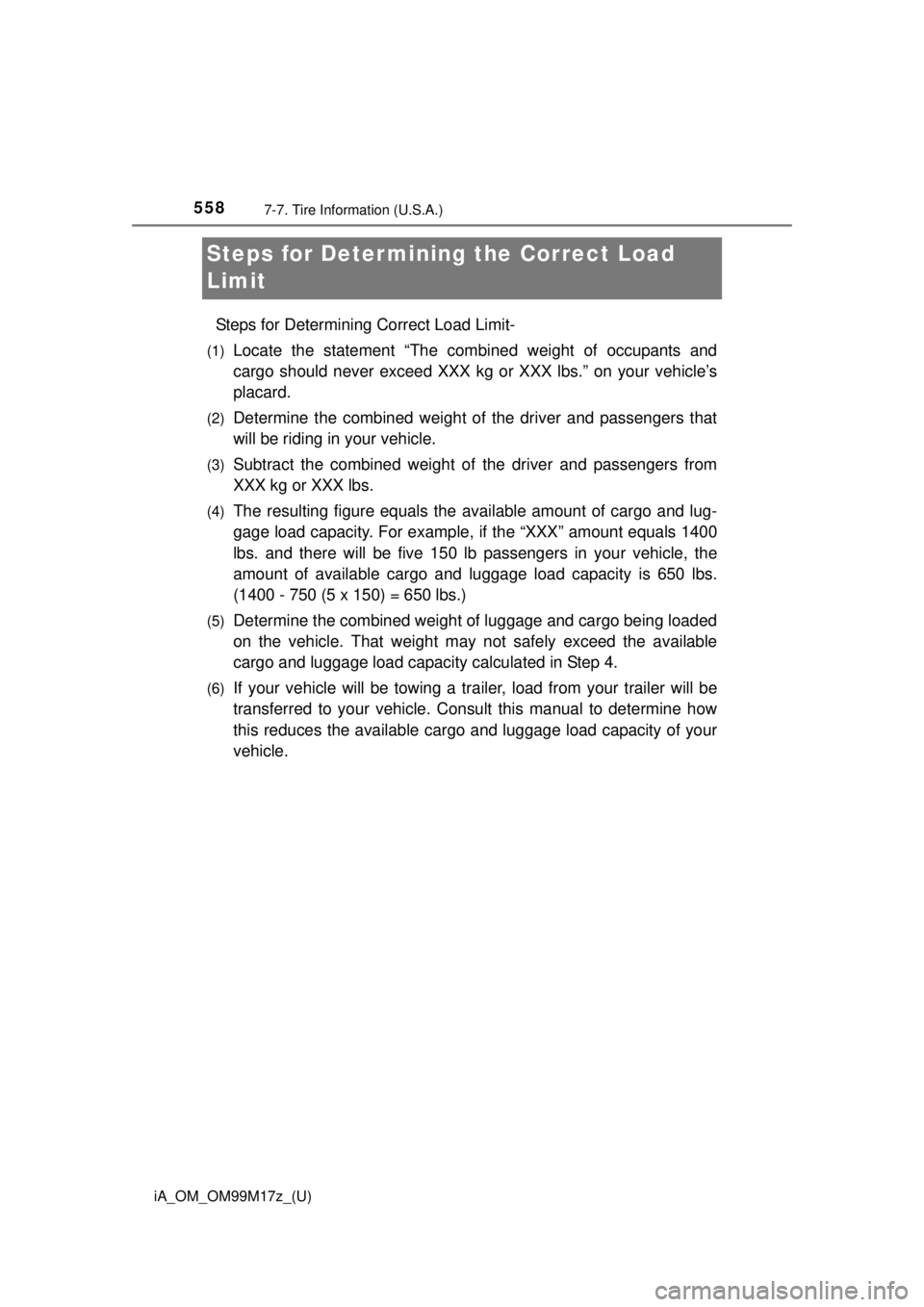
558
iA_OM_OM99M17z_(U)
7-7. Tire Information (U.S.A.)
Steps for Determining the Correct Load
Limit
Steps for Determining Correct Load Limit-
(1)Locate the statement “The combined weight of occupants and
cargo should never exceed XXX kg or XXX lbs.” on your vehicle’s
placard.
(2)Determine the combined weight of the driver and passengers that
will be riding in your vehicle.
(3)Subtract the combined weight of the driver and passengers from
XXX kg or XXX lbs.
(4)The resulting figure equals the available amount of cargo and lug-
gage load capacity. For example, if the “XXX” amount equals 1400
lbs. and there will be five 150 lb passengers in your vehicle, the
amount of available cargo and luggage load capacity is 650 lbs.
(1400 - 750 (5 x 150) = 650 lbs.)
(5)Determine the combined weight of luggage and cargo being loaded
on the vehicle. That weight ma y not safely exceed the available
cargo and luggage load capacity calculated in Step 4.
(6)If your vehicle will be towing a tr ailer, load from your trailer will be
transferred to your vehicle. Consult this manual to determine how
this reduces the available cargo and luggage load capacity of your
vehicle.
Page 559 of 588
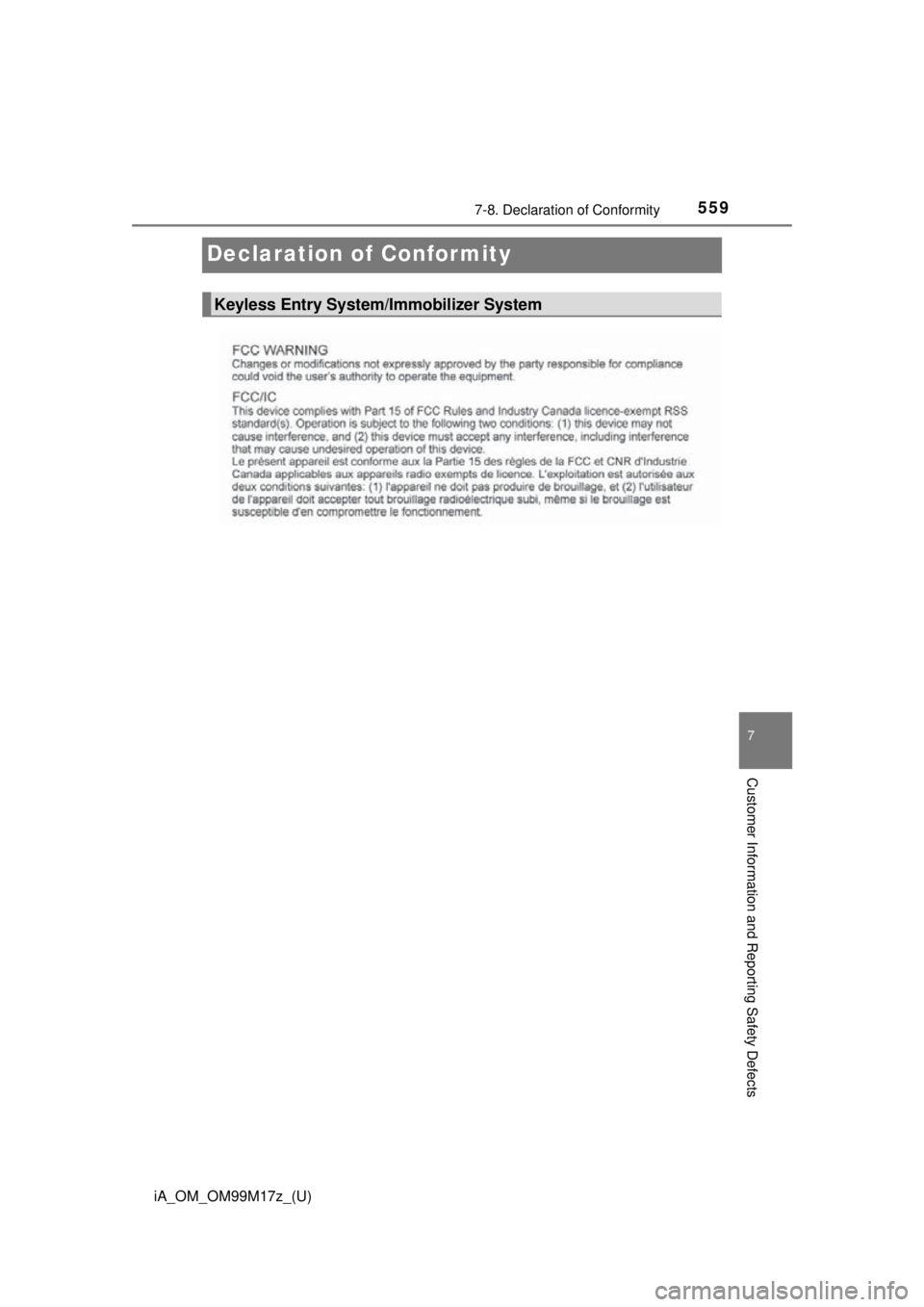
559
iA_OM_OM99M17z_(U)
7-8. Declaration of Conformity
7
Customer Information and Reporting Safety Defects
Declaration of Conformity
Keyless Entry System/Immobilizer System
Page 560 of 588

560
iA_OM_OM99M17z_(U)
7-8. Declaration of Conformity
■Ty p e A
For vehicles sold in the U.S.A. and Canada
FCC ID: CB2MBLUEC09 IC:279B-MBLUEC09
This device complies with Part 15 of the FCC Rules and with RSS-
210 of Industry Canada.
Operation is subject to the following two conditions:
(1)This device may not cause harmful interference, and
(2)This device must accept any in terference received, including
interference that may cause undesired operation.
The term “IC: ” before the radio certification number only signifies
that Industry Canada technica l specifications were met.
The antenna used for this transmitter must not be co-located or
operating in conjunction with any other antenna or transmitter. End-
users and installers must be provi ded with installation instructions
and transmitter operating conditions for satisfying RF exposure
compliance.
Scion Customer Experience
● U.S.A.
Phone: 1-866-70-SCION or 1-866-707-2466 (Toll-free)
Web: http://www.scion.com/BeSpoke
● Canada
Phone: 1-888-TOYOTA-8 or 1-888-869-6828 (Toll-free)
Web: www.toyota.ca
Bluetooth® Hands-Free
WARNING
Changes or modifications not expressly approved by the party responsible
for compliance could void the user’s authority to operate the equipment.